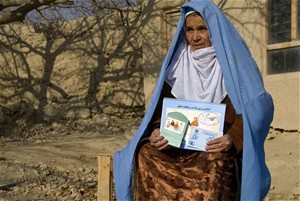
Bibi Gul Jamal displays prevention of postpartum hemorrhage educational materials.
HSSP/USAID
One out of eight Afghan women dies at childbirth. The most common cause of maternal mortality is postpartum hemorrhage
27 JULY 2011 | JAWZJAN, AFGHANISTAN
Bibi Gul Jamal works tirelessly as a community health worker to improve the health of women in her village of Komak-e-Omar Khan in the Jawzjan Province of northern Afghanistan. A few years ago, Bibi Gul tragically lost two daughters who both died from bleeding after childbirth. Both had experienced retained placenta, which is a common cause of postpartum bleeding. They lived at home without the assistance of a skilled provider, and far from the health facility. Bibi Gul says, “My heart is filled with the pain of losing my young daughters. No mother should ever suffer such pain.”
Like Bibi Gul’s daughters, women in Afghanistan face an enormous risk of dying during pregnancy and following delivery. About one out of every eight Afghan women dies from causes related to pregnancy and childbirth each year. The most common cause of maternal mortality in Afghanistan is bleeding after delivery, otherwise known as postpartum hemorrhage. About 80 percent of postpartum hemorrhage cases can be prevented during labor and delivery. However, the vast majority of births in Afghanistan occur without the assistance of a midwife or doctor—greatly increasing the risk of women dying from post-partum hemorrhage.
USAID is supporting the Ministry of Public Health to deliver community-based interventions that protect women from the risk of postpartum hemorrhage when delivering at home without assistance from a skilled provider. Community health workers are trained to identify and visit the homes of pregnant women in their communities. They educate the women about the importance of delivering with a skilled provider, danger signs in pregnancy and childbirth, and the main causes of postpartum hemorrhage and how it can be prevented. They also provide information about correct timing and use of the drug misoprostol to stop bleeding, and distribute it to the women for use immediately after childbirth where there are no skilled providers.
With this activity, USAID has assisted approximately 20,000 pregnant women in five of the most remote provinces of the country where access to skilled care at delivery remains a substantial challenge.

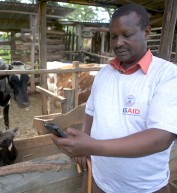

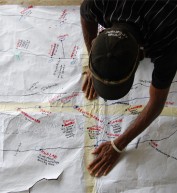
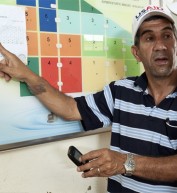

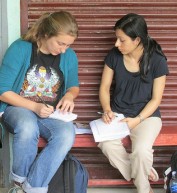
Comment
Make a general inquiry or suggest an improvement.